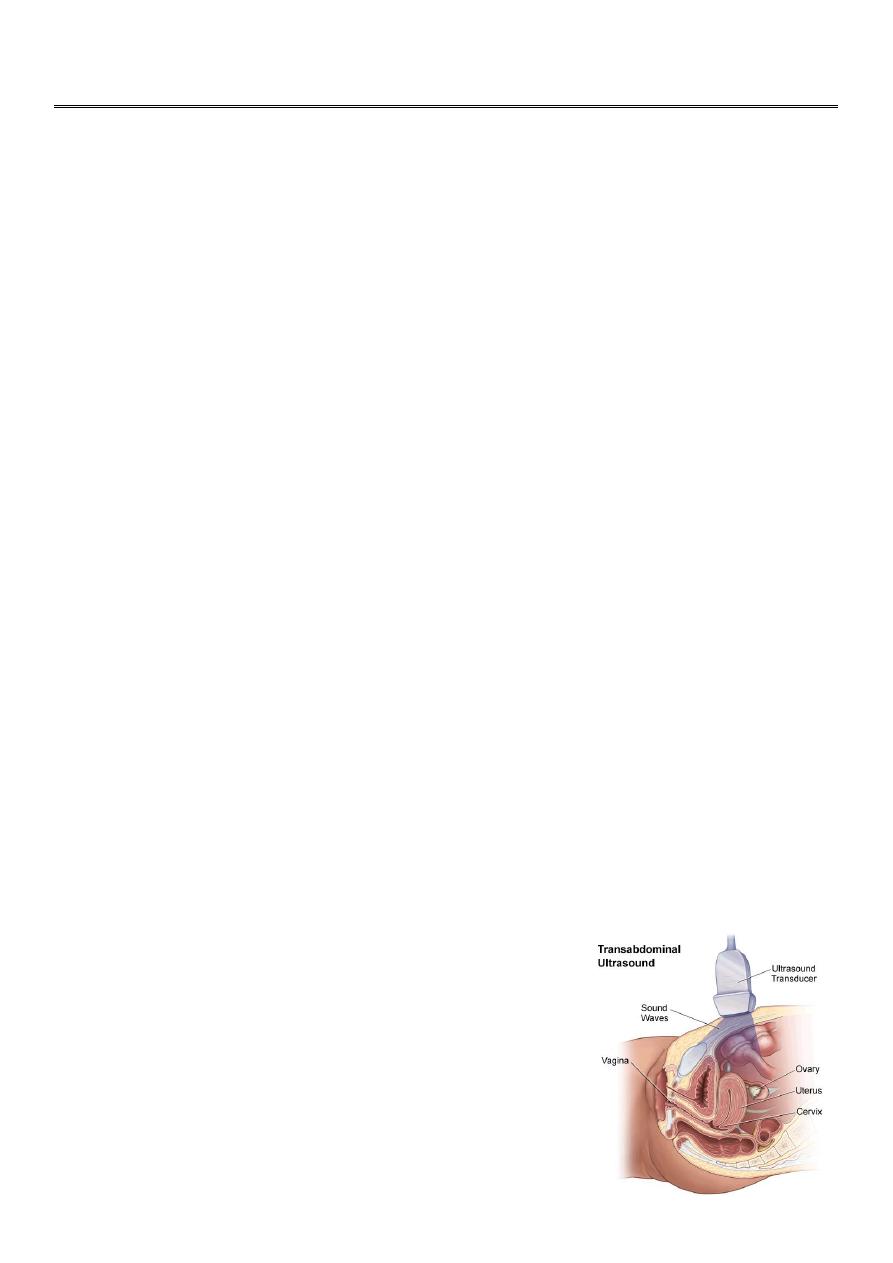
1
Fifth stage
Gynecology
Lec1
.د
سمير
1/1/2014
Ultrasonography in Gynecology
Introduction:
Ultrasound was first introduced by Ian Donald (Glasgow 1950) in the field of medicine
Sonography is widely used in Gynaecology either with the transabdominal (TAS) or
with the transvaginal (TVS) probe
Because of the safety, high patient acceptance and relatively low cost,
ultrasonography has become a common diagnostic modality in gynaecology these
days.
Use of Ultrasound in Gynecology:
Use of infertility workup
Serial measurement of ovarian follicular diameter (folliculometry) and endometrial
thickness are done using TVS.
Ultrasound can provide presumptive evidence of ovulation. Following ovulation,
internal echoes appear and free fluid is observed in pouch of Douglas.
To detect correcting time of ovulation by folliculometry in conjuction with plasma
oestradiol.
Sonographic guided oocyte retrieval in IVF and GIFT programmes.
Ectopic pregnancy can be detected on TVS as a “tubal ring” separate from the ovary in
a patient with empty uterine cavity.
Pelvic mass can be evaluated as regard to its location and consistency. Uterine fibroid,
ovarian mass, endometrioma, tubo-ovarian mass, etc. can be delineated when there
is confusion in clinical diagnosis.
Oncology: TV-CDS can assess the vascularity of the mass. Low flow impedance with a
high flow velocity raises the suspicion of a malignant tumor.
Endometrial disease: Women with unexplained uterine bleeding, or postmenopausal
bleeding.
Transabdominal sonography:
Is done with a linear or curvilinear array transducer
operating at 2.5-3.5 MHz.
TAS requires full bladder to displace the bowel out of
pelvis.
Other wise gas in the bowel acts as a complete
barrier to ultrasound waves.
TAS is best used for large masses like fibroid or
ovarian tumor
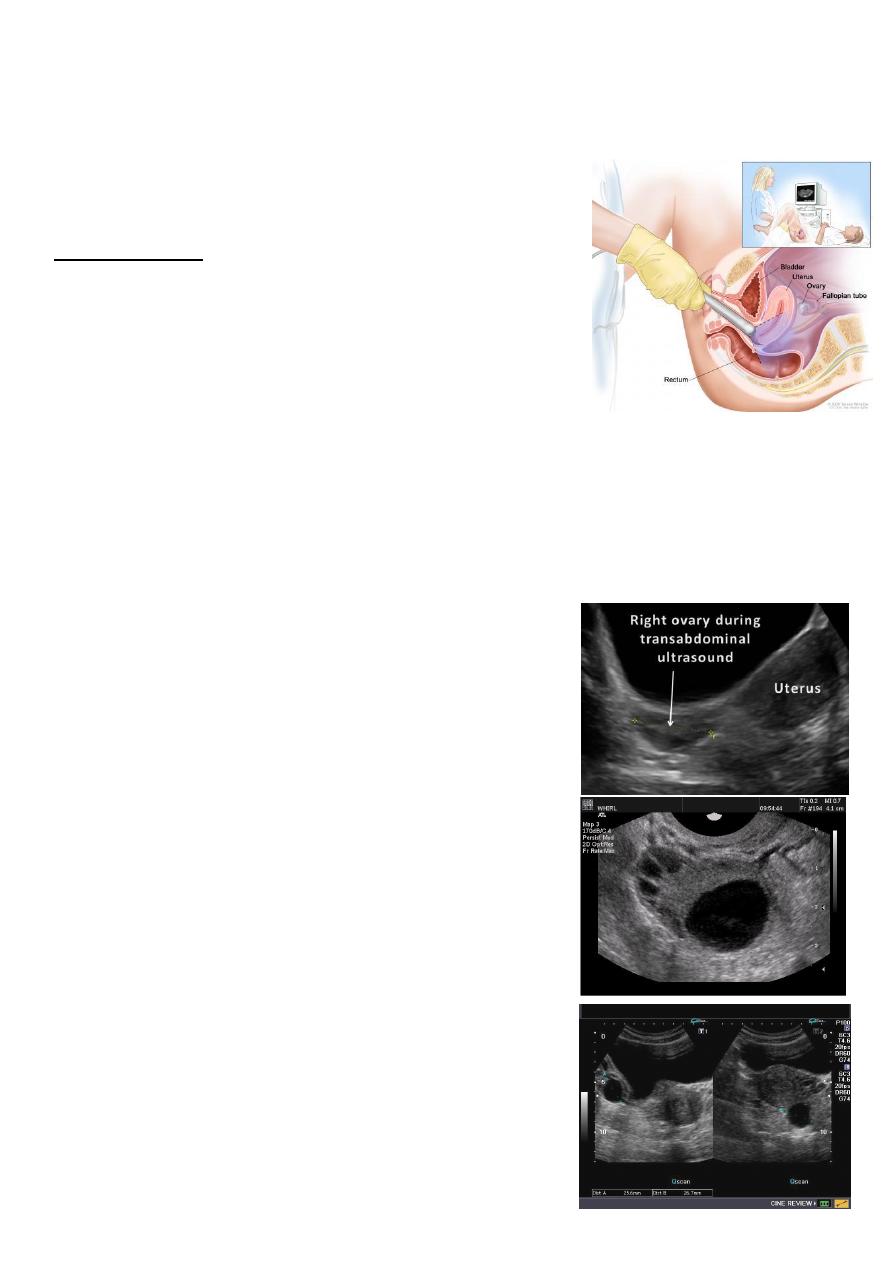
2
Higher is the frequency of ultrasound wave, better is the image resolution but lesser
is the depth of tissue penetration
Transvaginal Sonography (TVS)
It is done with a probe which is placed close to the
targt organ.
Preparing patient
There is no need of a full bladder
It also avoids the difficulties due to obesity, faced in
TAS
Transvaginal ultrasound may be done for the following
problems:
Abnormal findings on a physical exam, such as cysts,
fibroid tumors, or other growths
Abnormal vaginal bleeding and menstrual problems
Certain types of infertility
Ectopic pregnancy
Pelvic pain
TVS operates at a high frequency (5-8 MHz).
Therefore, detailed evaluation of the pelvic organs (within 10 cm of the field) is
possible with TVS.
But the drawbacks of TVS are mainly due to narrow
vagina as in virgins, postmenopausal women or post
radiation vaginal stenosis.
Ultrasound of Normal ovary
Normal ovary during a natural menstrual cycle
demonstrating normal follicle population and distribution
on day 12 postmenstruation. A dominant follicle is
visualized in the central portion of the image and several
subordinate follicles from the wave (2–5 mm) are observed
in the left lateral aspect of the ovary.
Functional cysts of the ovary - Follicular cysts:
This young female patient underwent sonography for non-
specific pain in the lower abdomen. Ultrasound images of
the pelvis show bilateral ovarian cysts which show absence
of internal nodules, septae or debris. These findings are
typical of follicular cysts of the ovaries. Follicular cysts are
functional cysts and are enlarged ovarian follicles that have
not ruptured (ovulated). They are usually unilateral.

3
Functional cysts of the ovary – Corpus Luteum cysts
Lt. adnexal cystic mass- Luteal cyst(Lt. ovary):
Rt. ovarian simple cyst:
Hemorrhagic ovarian cysts:
Hemorrhagic cyst of ovary resulting from Ovulation induction
This young nulliparous female patient undwerwent
ultrasonography following ovulation induction. The right
ovary shows a typical hemorrhagic cyst formed from the
corpus luteum. The first image (top row- left) is a
transabdominal ultrasound image showing fine fibrinous
strands within the cystic mass in the right ovary. Transvaginal
ultrasound and color Doppler images confirm these findings.
The uterus shows typical secretory changes in the
endometrium suggesting post ovulatory phase.
Hemorrhagic ovarian cysts:
Hemorrhagic cyst of ovary with co-existing chocolate cyst/
endometrioma:
This patient has a co-existing chocolate cyst with a
hemorrhagic cyst in the same (right) ovary. The cyst on the left
half of the ultrasound image is a hemorrhagic cyst. Note the
fine fibrinous strands within the cyst suggesting clot
formation. The cyst on the right half of the image is
homogenous with fine echoes throughout the ovarian cyst.
This is a typical appearance of an endometrioma (chocolate cyst)
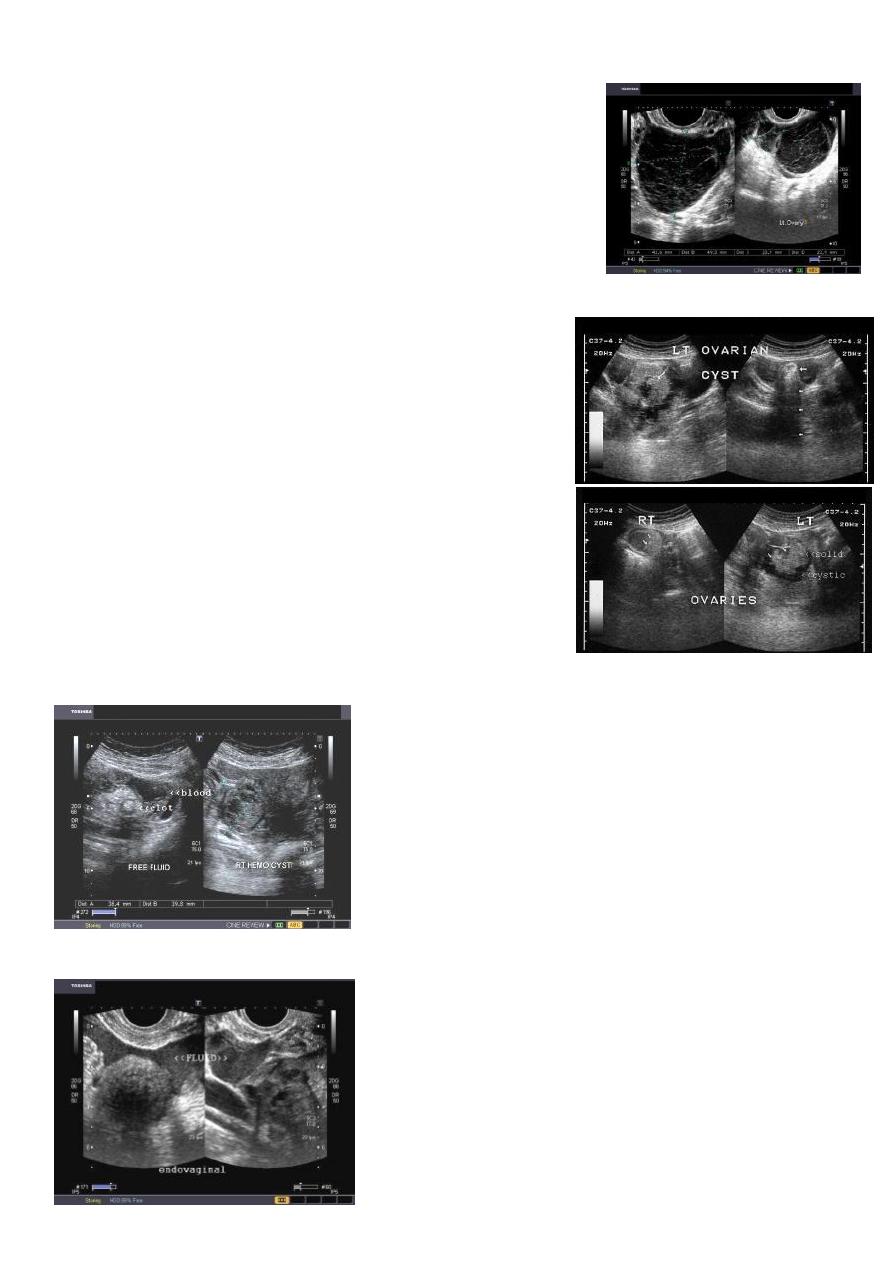
4
Hemorrhagic ovarian cysts:
Hemorrhagic cyst of ovary with ruptured ectopic pregnancy:
This female patient has a left ovarian hemorrhagic cyst (see
ultrasound image above-left). In addition, there is a large
collection of free fluid with particulate matter in the pelvis.
The right fallopian tube is thickened with a ring shaped mass.
This suggests that there is significant hemorrhage into the
pelvis due to a ruptured ectopic pregnancy (right tubal ectopic
gestation). The left ovarian hemorrhagic cyst appears intact,
ruling out ruptured hemorrhagic cyst.
Ovarian dermoid cyst or Cystic teratomas:
These ultrasound images reveal bilateral ovarian complex
masses that contain both solid and cystic components. The
right ovary shows a cystic mass with a solid, highly
echogenic "dermoid plug". This is a solid nodule containing
fat and various tissues including hair. Posterior acoustic
shadowing is seen. The left ovary shows a dermoid plug
and, in addition, a "dermoid mesh" is also seen, an
irregular echogenic solid mass within the cyst. Echogenic
debris is seen floating within the fluid
Rupture of hemorrhagic ovarian cyst:
Transabdominal scanned image
Transvaginal scanned image
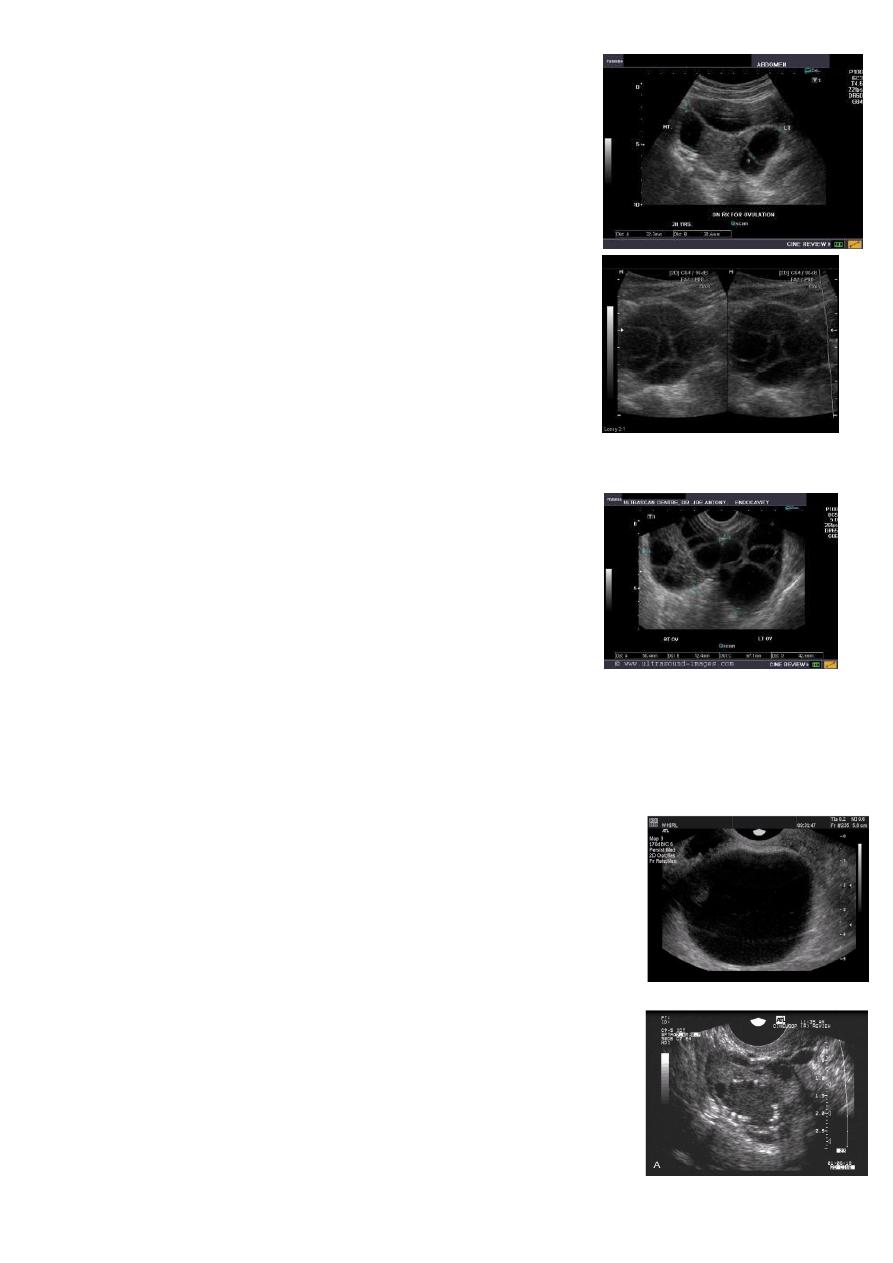
5
Ovarian hyperstimulation syndrome (OHSS):
This young adult female patient was examined to evaluate the
uterus and ovaries. She was under treatment for infertility and
was using gonadotropins. Ultrasound images of the ovaries
show grossly enlarged ovaries with large cysts (measuring 2.6
to 3 cms.) in both ovaries. These ultrasound findings are
diagnostic of OHSS or ovarian hyperstimulation syndrome.
The ultrasound image again show hyperstimulated ovaries.
Both ovaries are grossly enlarged and cystic.
Transvaginal ultrasound images of ovarian hyperstimulation syndrome:
This young adult female patient showed multiple large theca
lutein cysts of both ovaries, arranged in spoke-wheel pattern
(ultrasound images above) which were the result of use of
gonadotropins in the management of infertility. The cysts vary
in size from 2 to 4 cms. with the ovaries massively enlarged
(each ovary measures up to 7 cms. in size). This can be
classified as grade-2 hyperstimulation of the ovaries (ovarian
diameter from 5 to 10 cms.). There is not evidence of ascites. The color Doppler image of
the ovaries shows vessels passing along the margins of the cysts. One of the complications
of such enlarged ovaries in OHSS is torsion and in certain cases rupture of the ovaries, both
of which are medical emergencies. Ovarian hyperstimulation syndrome is known to occur
more frequently in patients of pre-existing Polycystic ovaries (PCO).
PERSISTENT ANOVULATORY FOLLICLE
Failure of ovulation and development of “cystic” follicle. The follicle
typically grows larger than the mean preovulatory follicle diameter
of 23 mm, thin atretic follicle walls are observed and small flecks of
particulate matter are frequently seen in the lumen or aggregated
at the side of the structure.
BENIGN OVARIAN NEOPLASIA
Images of a small intraovarian dermoid cyst (A, B). The cyst is
completely embedded in the ovary and is surrounded by focal
areas of hyperechoicity. Small follicles are observed in the
surrounding stroma. Folliculogenesis and ovulation were impaired
in this ovary. The contralateral ovary demonstrated compensatory
hypertrophy.
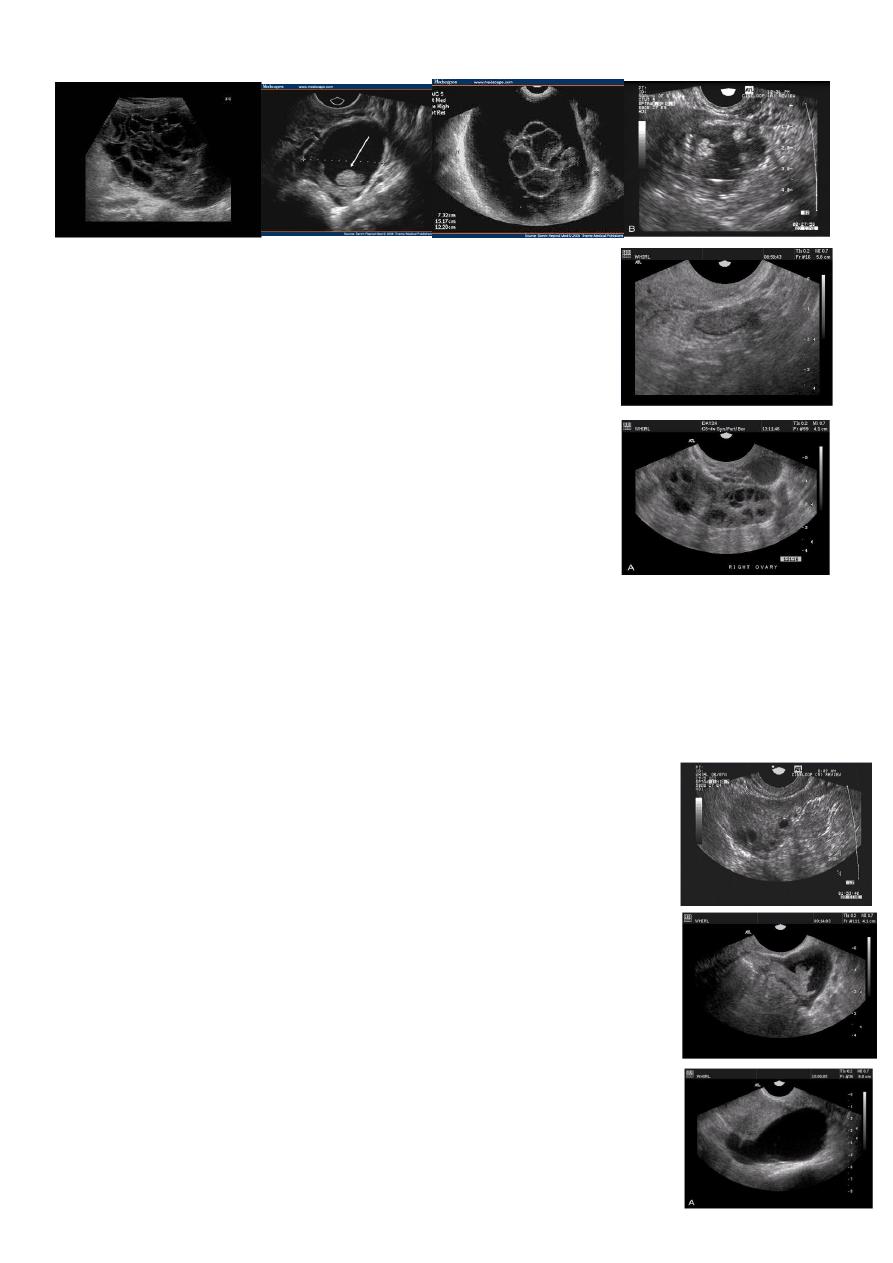
6
Images of a small intraovarian dermoid cyst
Premature ovarian failure.
Image from a woman in premature ovarian failure. Only the
stroma of the ovary is identified. A very few follicles of less than
1 mm diameter can be observed on the inferior aspect of the
ovary.
POLYCYSTIC OVARY SYNDROME
Images from women with differing expressions of the four major
subtypes of the metabolic syndrome associated with polycystic
ovary syndrome (A–D). The images exhibit quite differing
ultrasonographic appearances in the size and distribution of
follicles within PCOS ovaries. A recent corpus luteum is clearly
visible in the ovary in panel (D).
The Oviduct (Fallopian Tube)
Normal Oviduct
An image of an oviduct visualized from the uterine cornu to the fimbria.
The ampulla, infundibulum and very fine interfaces representing the
fimbria may be appreciated on the superior aspects of the ovaries.
The fimbria of the oviduct are clearly visualized in free fluid surrounding
the ovary following ovulation or hysterosalpinography.
Hydrosalpinx
Hydrosalpinx is usually easily diagnosed as well-constrained fluid
accumulation in the adnexae. In some cases, adhesions between the
oviduct and ovary may be visualized.
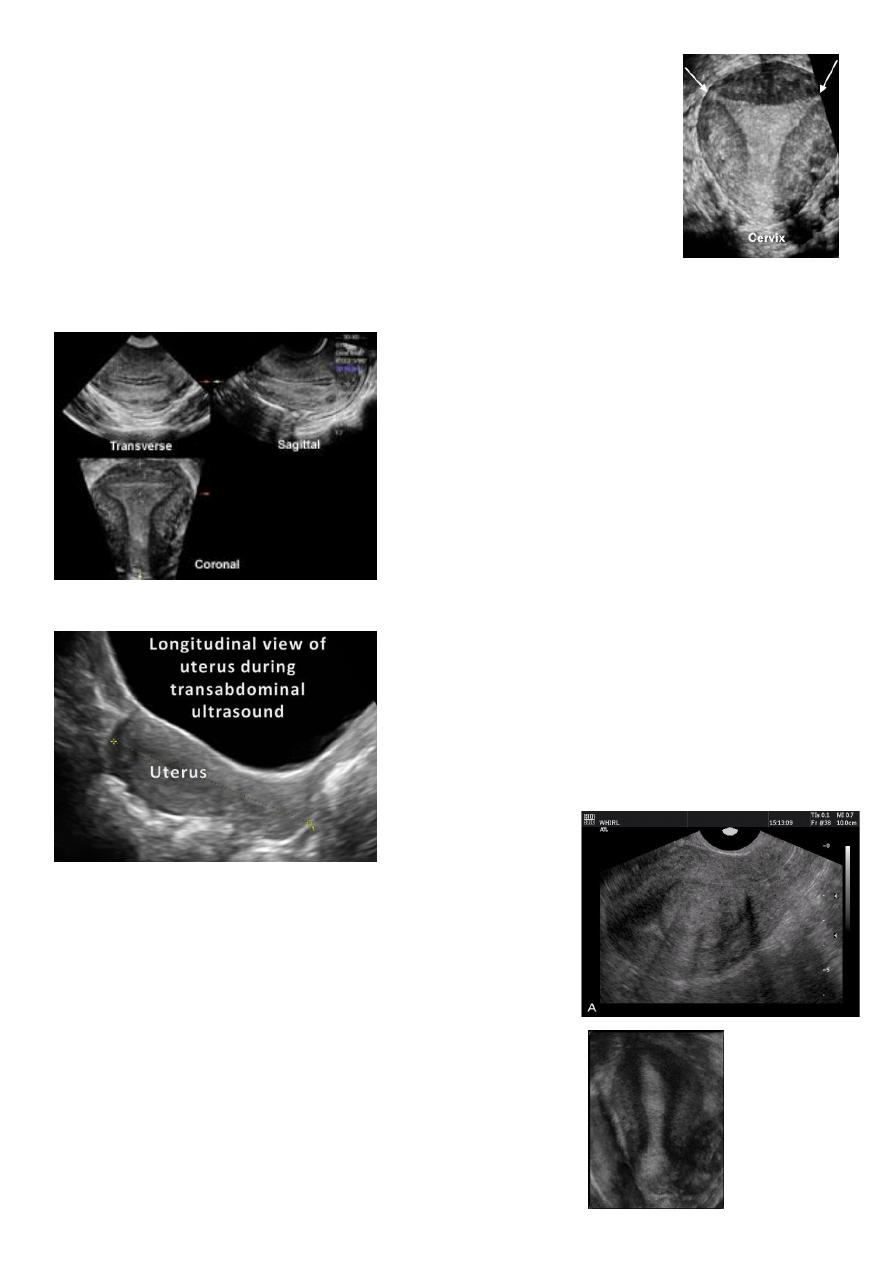
7
Uterus
Reconstructed coronal view of the uterus demonstrating cornuas
(arrow) and cervix, with a normal uterine contour
Normal Uterus
Planar views of normal uterus using volume contast imaging
Normal Uterus in longitudinal view
Fibroids (leiomyomata)
Intramural leiomyomata are frequently visualized. Examples
of fibroids which compromise the contours of the
endometrial cavity are shown (A–D). Refraction artifacts
resulting from tissue density interfaces and the texture of
the fibroids often aid in their identification.
Congenital anomalies of uterus
Unicornuate uterus
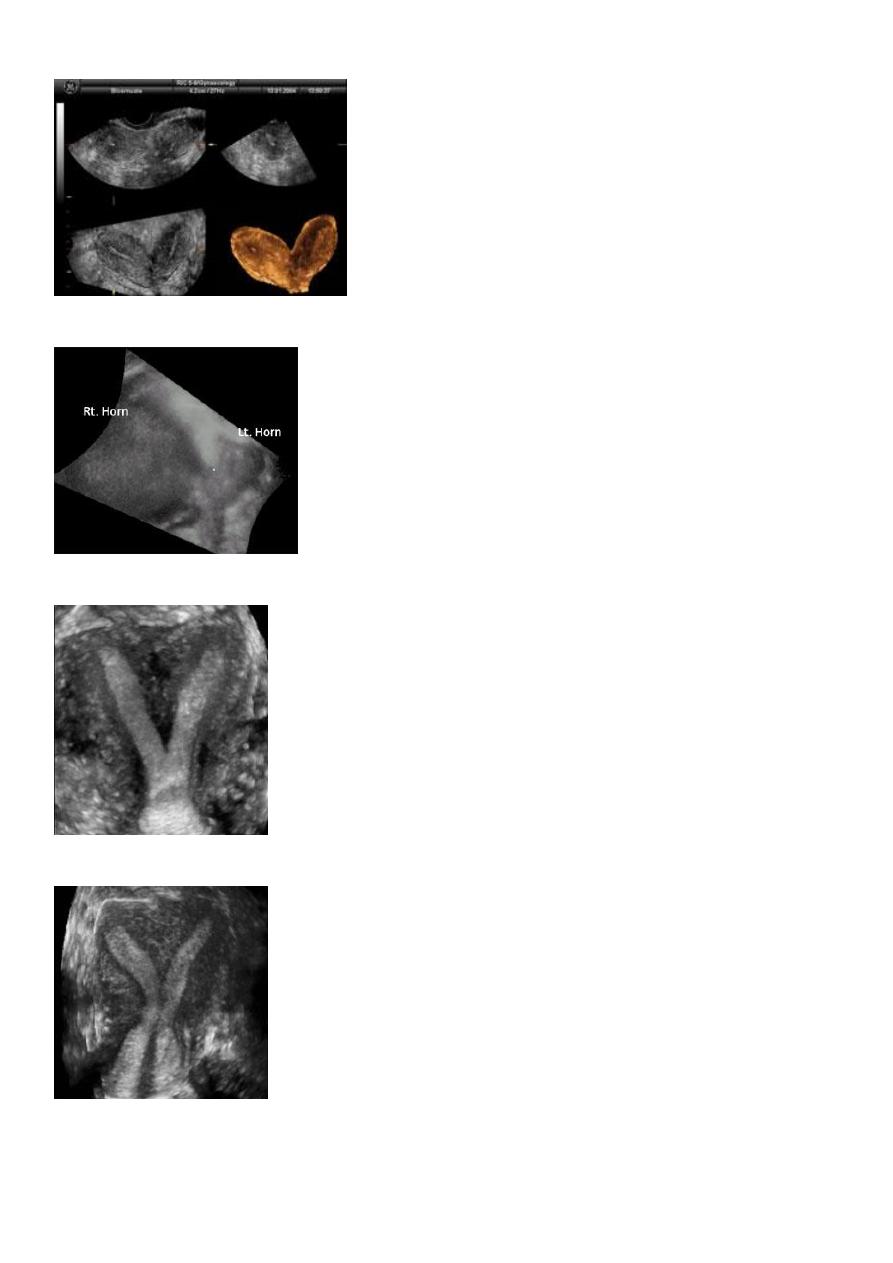
8
Bicornuate Bicollis Uterus
Didelphic uterus with Left sided hematometra
Subseptate Uterus
Complete Septate
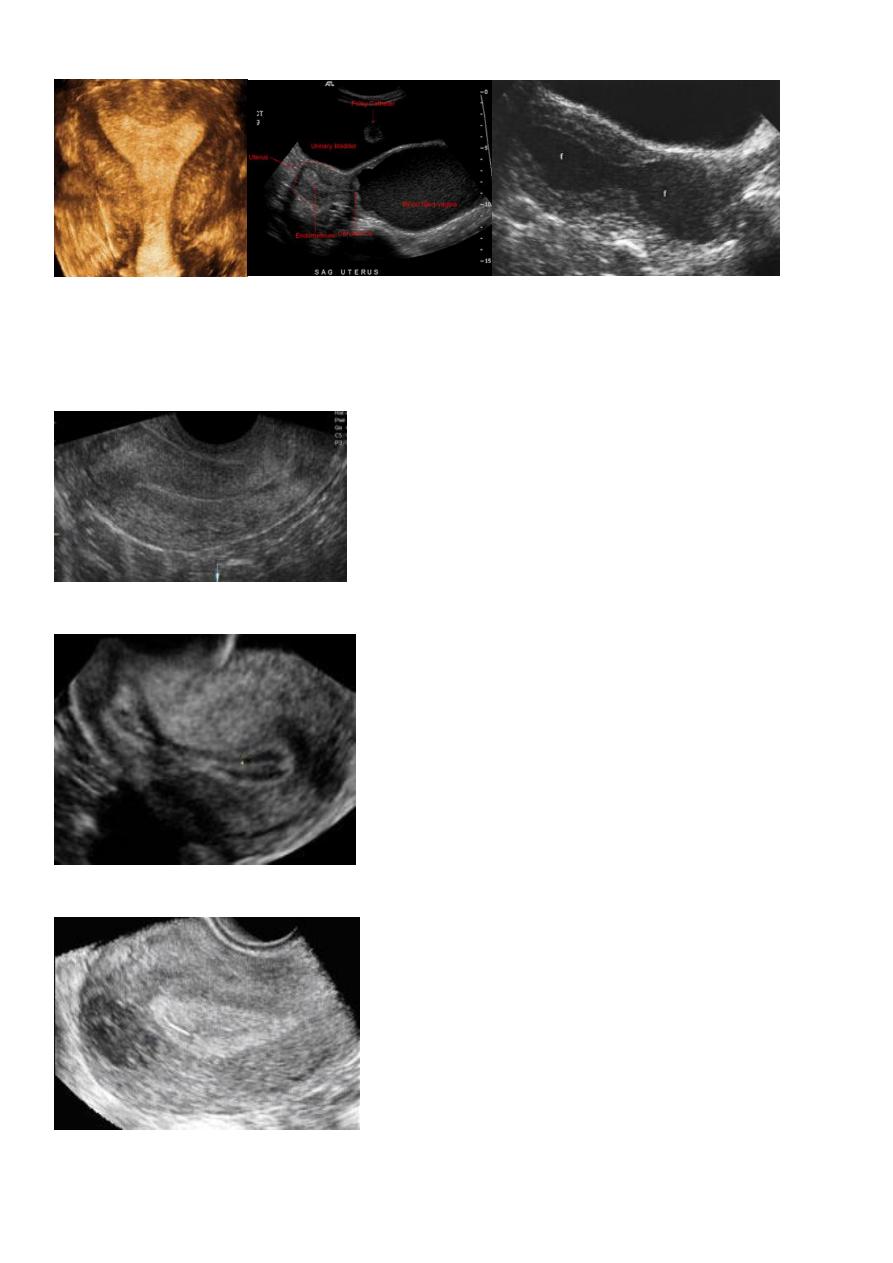
9
Arcuate uterus
Endometrium
Post menstruation
Trilaminar appearance during proliferation
Secretory phase
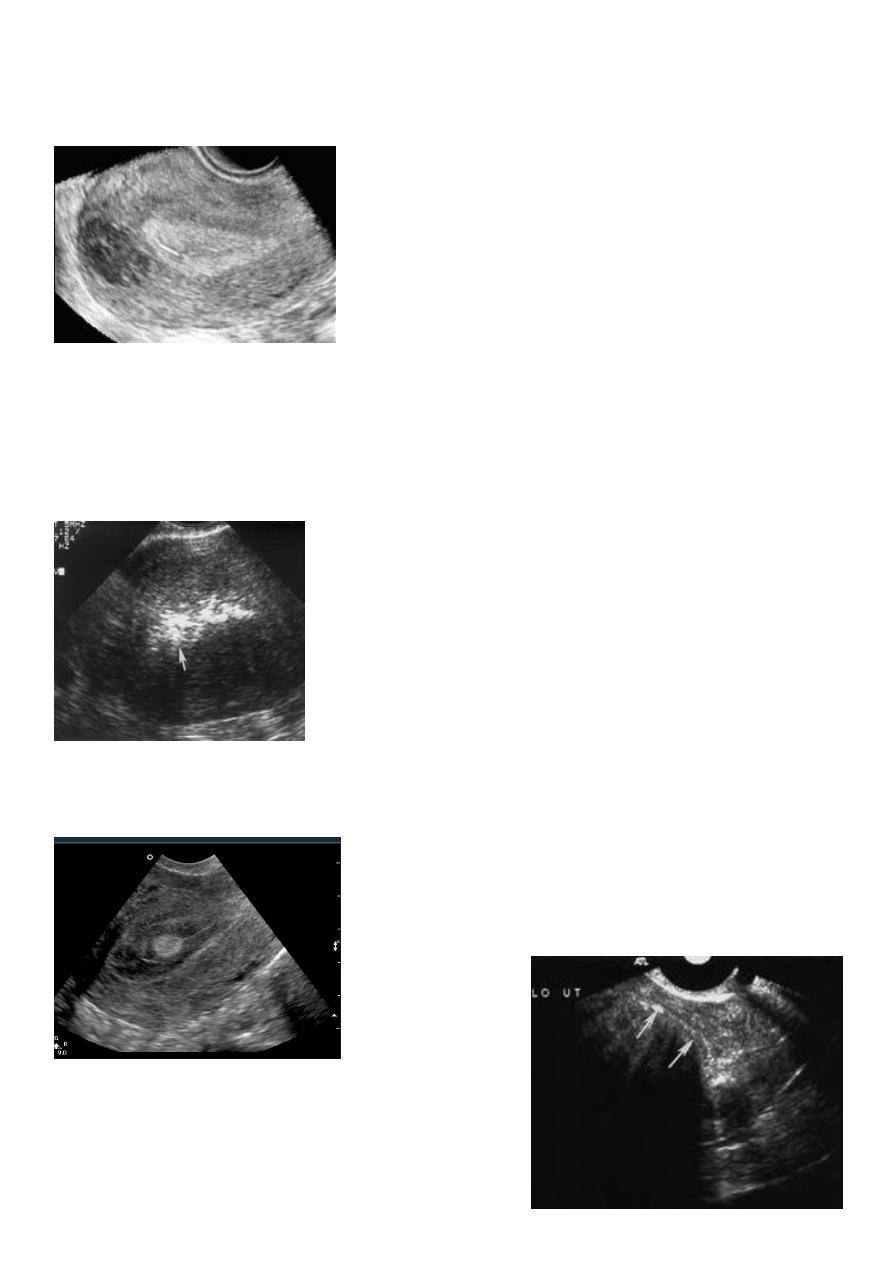
11
Premenopausal Endometrium
Sagittal US image of the uterus obtained during the secretory phase of the menstrual
cycle shows a thickened, echogenic endometrium (cursors).
Pathology of Endometrium
Endometritis. US image demonstrates multiple echogenic foci within the endometrium
(arrow) representing gas.
Endomaterial polyp
Submucosal fibroid. (a) Transvaginal US image reveals
a uterine mass (arrows) with posterior acoustic
shadowing.
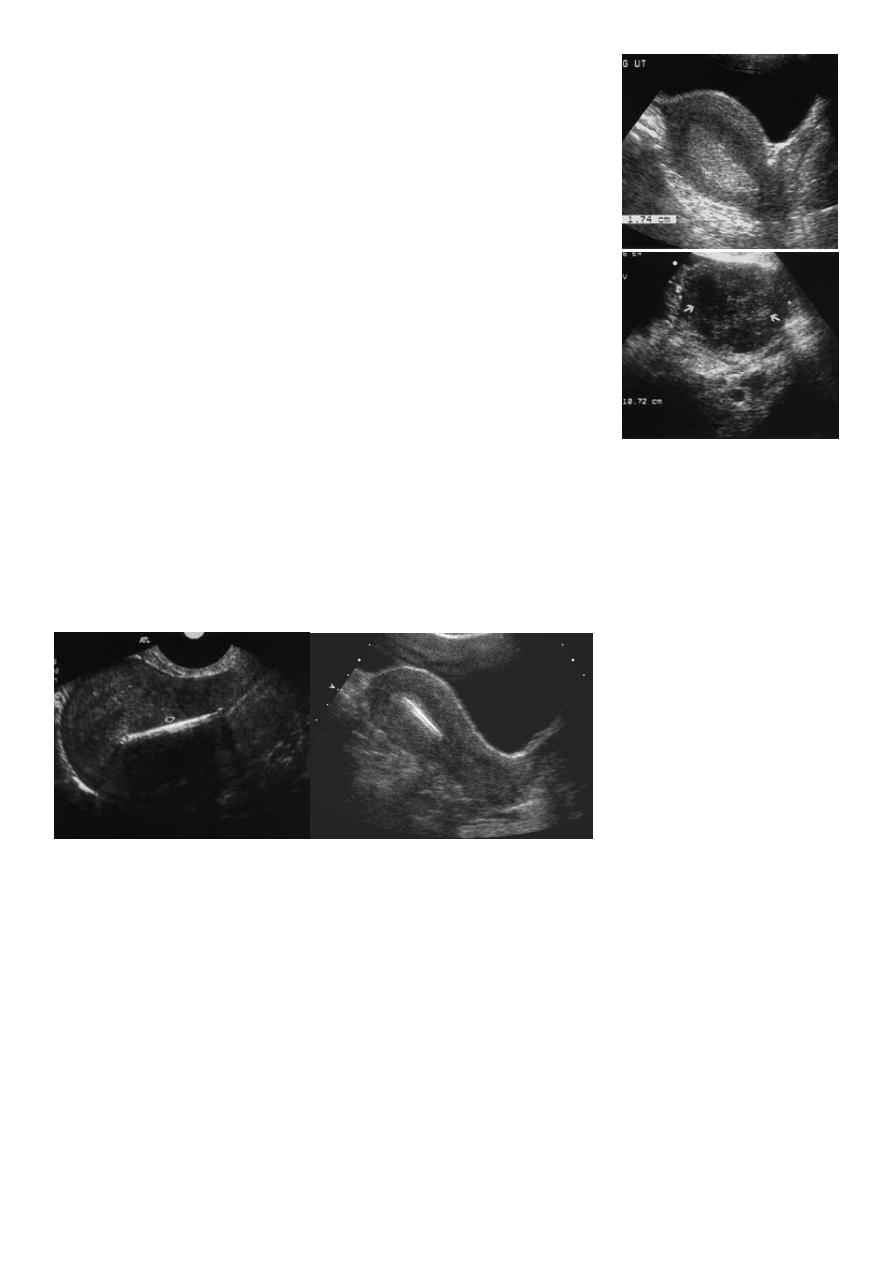
11
Endometrial hyperplasia. US image shows an endometrium
with diffuse thickening (maximum thickness, 1.74 cm) due to
hyperplasia (cursors). This finding was confirmed at biopsy.
Endometrial adenocarcinoma.
(a) US image reveals a heterogeneous endometrial mass
(arrows) that is difficult to distinguish from the myometrium.
Cursors indicate the entire transverse width of the uterus.
IUD
IUD. US image shows a hyperechoic linear structure within the endometrial canal
(arrow) representing an IUD.
